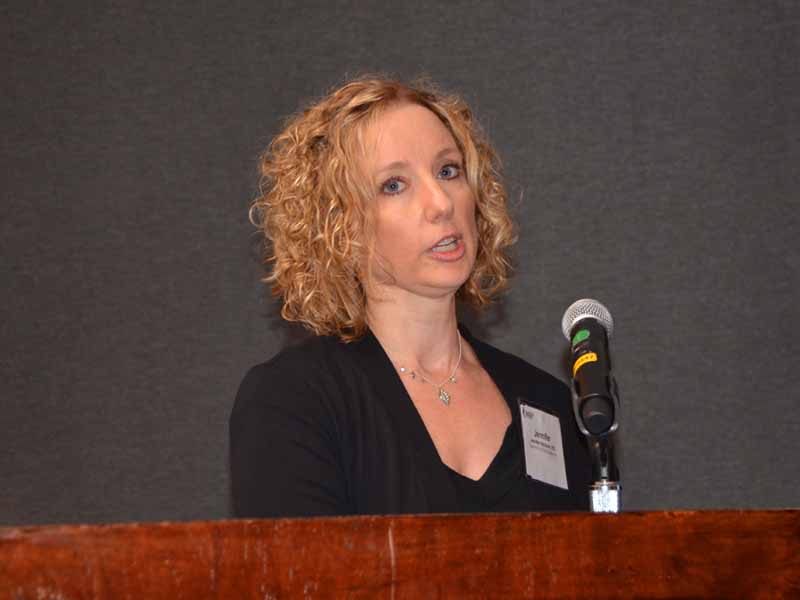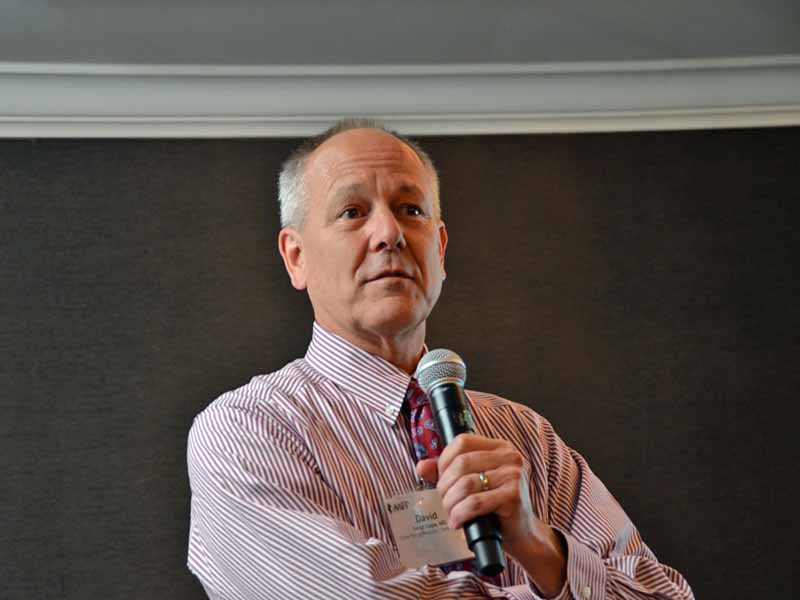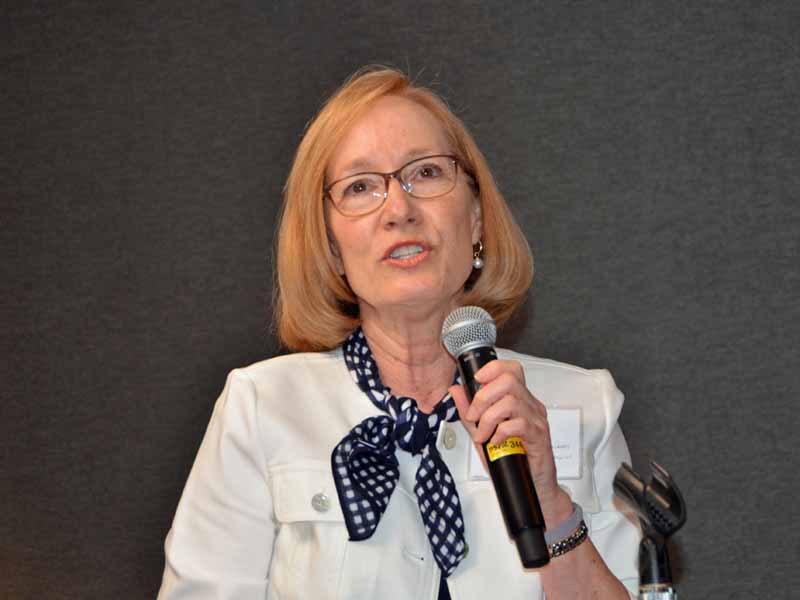FPs Share Best Practices at Adolescent Immunization Summit
July 18, 2018, 03:58 pm Chris Crawford Kansas City, Mo. – During the AAFP's Adolescent Immunization Best Practices Summit held here July 14-15, participants shared stories of how they used evidence-based interventions and system changes to improve immunization rates for adolescents ages 11-18.
In addition to the family physicians in attendance, participants included external immunization partners from the American Academy of Pediatrics (AAP), American College of Obstetricians and Gynecologists, Association of Immunization Managers, CDC, Immunization Action Coalition, National Association of School Nurses, and the Society for Adolescent Health and Medicine.
The summit was supported by an unrestricted grant from Sanofi Pasteur.
Family Physicians' Best Practices
Jennifer Schriever, M.D., from Sioux Falls, S.D., said she has been actively working since 2013 with her clinic in the Sanford Health system to improve adolescent immunization rates.
She said opportunities to recommend vaccines to adolescent patients cannot be missed.

Jennifer Schriever, M.D., from Sioux Falls, S.D., explains that Sanford Health created a VAX Champ program to train nurses in all its clinics, including hers, to administer vaccines, led by an onsite immunization expert.
When Schriever's clinic started the initiative, a staff member would go through the 10 physicians' schedules for the month and see which patients were due for vaccines. That list was given to each physician and their nurses.
Now, the group has gotten used to regularly reviewing which patients are due for immunizations by using an immunization section in its electronic health record (EHR).
"So, nurses, as they're rooming, can look easily at an immunizations section in the EHR, or a best practice section, and know what vaccines the patient is due for," Schriever said.
The practice has protocol orders for all vaccines, so nurses don't need an order from a physician to administer immunizations for anything other than category B recommendations.
Vaccines are available at all clinics in the system for walk-ins, and a nurse is available at its acute care facility during extended hours on Wednesday nights solely to give vaccines.
Story Highlights
Sanford Health also recently created a VAX Champ program led by an onsite immunization expert to train nurses in all its clinics to administer vaccines.
Having an immunization champion in the office was a reoccurring theme among the family physicians who spoke at the summit.
Kristen Royer, M.D., of Lafayette, Colo., said her medical assistant (MA) at Family Medical Associates of Lafayette served as the immunization champion, helping other MAs log on to the state immunization registry; ordering vaccines, including for the Vaccines for Children program; and disseminating vaccine information to the full staff.
Royer said it also was helpful that her practice created standing orders for the four recommended adolescent vaccines.
John Merrill-Steskal, M.D., of Ellensburg, Wash., agreed about the importance of having an immunization champion at his practice, Kittitas Valley Healthcare.
"I cannot emphasize enough the importance of having medical assistants and nurses as immunization champions," he said. "To implement any change in a practice, it's really important to have someone who feels similarly passionate that isn't a physician."
Merrill-Steskal added that he felt the key to his office improving adolescent immunization rates was creating a checkbox on the group's EHR to acknowledge each patient's vaccine status.
"Many EHRs have flagged alerts that say a vaccine is due, but I feel like physically having to check a box helps entrench action in giving recommended vaccines," he said.
Merrill-Steskal also said standing orders empowered MAs to give vaccines. "It wasn't uncommon to see physicians coming out of rooms at the end of the visit thinking they were done, and the medical assistant was heading into the room with a vaccine to administer that they had noticed but the physician hadn't."
Another innovative idea: Abigail Ho, M.S.N., M.P.H., FNP-C, of Rocky Run Family Medicine in Centreville, Va., said her office recently added touchscreen monitors in its exam rooms that patients can use to search for information on health topics, including vaccines.
"Every time I go into a room now, I see patients on the touchscreens looking up health information, which is a lot of fun and sparks a lot of different conversations," she said.
Removing Barriers
Ho explained that her office reshapes the conversation to overcome a barrier that many family medicine practices (including those represented at the summit) face in improving HPV vaccine rates in adolescents. The discussion becomes about using the quadrivalent HPV vaccine (HPV4; Gardasil) as a prevention tool.
If parents are concerned about giving their child at age 9-10 the HPV vaccine because it deals with sexual activity, Ho said, "In front of the child, we say, 'I'm not recommending that they be sexually active. My recommendation is abstinence. This is a preventive vaccine. Think of it like a seat belt -- you need your seat belt on before you ever start driving a car."
Another barrier participants mentioned is getting staff buy-in, especially on extra work MAs and front-desk staff need to do.
David Cope, M.D., who practices at Cope Family Medicine/Ogden Clinic in Bountiful, Utah, said at first, there was resistance in his office to the suggestion that improving adolescent vaccine rates would require calling patients more for reminders.
"They said callbacks would take too much time," he said. "Initially, it probably did, as there were several hundred calls to make. Now that it's every month in my practice, there are probably only 20 to 30 calls to make each time. The staff has seen the benefits of this work and they certainly have bought into it."
Jacqueline Huynh, M.D., said the University of Arizona Family Medicine Residency Clinic in Tucson, Ariz., where she practices, had a pretty major barrier to improving teen vaccine rates.

David Cope, M.D., of Bountiful, Utah, says the initial resistance of his office staff to implementing call reminders about adolescent immunizations dissipated after they saw the benefits of their efforts.
"About half of our clinical staff was shooting us in the foot as they weren't pro-vaccine at all," she said. "Our medical staff would come into the exam room with a vaccine and say, 'Well, personally, I wouldn't recommend the HPV vaccine,' or 'The flu vaccine doesn't work -- I don't recommend it.' Patients were changing their minds and not getting vaccinated."
Also, a survey of the clinical staff -- from the receptionist to residents, MAs and nurses -- revealed that 75 percent of employees couldn't identify the four vaccines recommended for the adolescent age group, Huynh said.
"For provider education, we picked out the most common misconceptions and provided them with correct information and standardized language to use during patient visits," she said. "At an all-clinic staff meeting, we said, 'This is our clinic's stance; you may have your own personal perceptions or hesitancy, but you cannot speak against these vaccines with patients.'"
The University of Arizona Family Medicine Residency Clinic also created videos for adolescent patients with a family physician's answers to common questions about each recommended vaccine. The videos also are used to train new residents and interns.
To bypass barriers that stand in the way of adolescents getting annual flu shots, including the perception that their immunity is strong enough that they don't need the vaccine, Marlon Weis, M.D., of Lincoln, Neb., offered simple advice.
"I tell adolescents they should get the flu vaccine for their parents and grandparents," he said. "That's who you are protecting."
Organizational Support/Resources
In addition to best practices from family physicians, representatives shared organizational support and resources that family physicians could use to help improve adolescent vaccine rates.
First off, Bellinda Schoof, M.H.A., director of the AAFP's Health of the Public and Science Division, presented initial results from a recent survey sent to a random sample of Academy members.
"Eighty-eight percent of members indicated they provide immunizations to adolescents," Schoof said. "And most provide immunizations to patients ages 11 and older."
Additionally, 93 percent of respondents said they encourage adolescents ages 11-18 to schedule a visit for clinical preventive services, which is an opportunity to check patients' immunization status, she added.
When asked if they scheduled 16-year-old patients for their adolescent immunizations, 46 percent of respondents said yes, indicating a chance to boost rates.
Only 34 percent of practices had implemented a quality improvement model to assess system changes and interventions to increase adolescent immunization rates.
"This also is an opportunity for improvement, to look at immunization champions' work, data, systems used and practice workflow to determine what works best and what doesn't," Schoof said.
Finally, 72 percent of respondents said they would like updated adolescent immunization fact sheets to use as office resources.

Jane Goleman, M.D., who represented the American Academy of Pediatrics at the AAFP's Adolescent Immunization Best Practices Summit, recommends the association's new flipchart called "A Guide to Adolescent Immunizations."
Jane Goleman, M.D., who represented the AAP at the summit, recommended the association's new flipchart called "A Guide to Adolescent Immunizations."
"The flipchart includes information on all of the adolescent immunizations, and it has cool infographics on the front of the chart that parents/adolescent patients can look at while the physician reads the back of the chart for talking points on each vaccine," she said.
Melinda Wharton, M.D., M.P.H., who represented the CDC, offered a tip on getting colleagues to buy into providing strong recommendations for adolescents on the HPV vaccine, no matter their beliefs or hesitancy, which she heard during a visit to the resident clinic at the University of South Alabama College of Medicine.
"They asked at the end of a training session for residents, 'Are you confident that you can give a strong recommendation,'" she said. "It wasn't, 'Do you harbor anti-vaccine beliefs' and it wasn't a judgmental question."
Jean Grabeel, R.N., explained that the National Association of School Nurses' 17,000 members have been promoting influenza immunization for years, and she personally has been part of a program to vaccinate students onsite in their schools in Springfield, Mo., since 2009.
"We partnered with our health department and two major health systems within Springfield, as well as our federally qualified health center, to come into the school sites to provide 10,000 flu vaccines," she said. "I've looked at our attendance rates since 2009, and students who received the flu vaccine versus those who did not had better attendance."
Finally, Claire Hannan, M.P.H., executive director of the Association of Immunization Managers, said the Maryland Partnership for Prevention developed an app to address the common hassles of obtaining paper consent forms from parents for flu vaccines.
"They then could collect the consent forms and insurance information electronically, which cut down on time to enter the information and improved their efficiency for billing," she said.
Hannan said currently, the Maryland group is actively reaching out to other states about sharing the app for their vaccination efforts.
Related AAFP News Coverage
AAFP Hosts Webinar on Teen, Young Adult Preventive Care
Topics Include Allotting Confidential One-on-One Time
(7/3/2018)
More From AAFP
Familydoctor.org: Adolescents and Young Adults: Getting the Preventive Services You Need